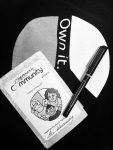The 5 W’s
…OR THE THREE M’S – MAKING METRICS MATTER!
On Track September 2013
Zingerman’s is an Open Book business.
I love working in an Open Book business. I believe that it is a way of operating that respects and harnesses the true potential of every single employee in the business. I also believe that although it can be a more challenging way to operate, the rewards – both philosophically and to the business’ bottom lines – are well worth the effort.
The core of Open Book is education and execution.
Educate each and every person in the business about the key business metrics – financial or otherwise – and review the status of the metrics in an accessible manner on a regular basis. Here at Zingerman’s, we call that keeping score. The metrics are displayed on a whiteboard, called the Department Operating Report (DOR). Each metric is “owned” by an employee who is responsible for that particular metric meeting its goal. Each DOR line owner reports on their metric in our weekly staff meetings called Huddles. They’re fun, fiesty meetings and the work of running the business gets done in those huddles.
All of which is splendid but would not lead to much if the business did not enable each employee to make and, more significantly, execute decisions about the metrics they own. Enabling, a very positive word in this context, is about giving employees decision making power and the resources they need to execute their decisions. But it is also about much more than resources and decision making power. It is about trusting each employee to (at least want to) make the decision that’s best for the business and coaching them in a constructive manner when they make mistakes – which they will. At Zingerman’s, we don’t just enable each employee to impact the metric they “own”, we expect them to.
If education and execution are the core of Open Book philosophy, choosing the right metrics and defining them clearly are what its success hinges on. And that is what I really want to talk about in this edition of OnTrack : how to go about defining your metrics clearly.
At Zingerman’s we have three bottom lines – great food, great service and great finance, and that’s what our metrics are based on. What metrics do you use to define the success of your business?
Years ago, when we started practicing Open Book, we realized the efficacy of our huddles could be vastly improved if we made sure that the metrics we had chosen were clearly defined. Why, you ask? Here’s a list of reasons :
- It’s efficient – if you aren’t discussing what the metric actually means every week, you have more time to discuss how to improve it!
- A clear definition provides an outline for the Line Owner’s report in the huddle each week.
- It is a crucial part of the education piece I spoke of earlier
- It creates an archive of consistent data that can be used to come up with business plans and targets in the future.
- What is the metric?
- Who owns it?
- What is the calculation?
- Where does the information come from?
- Why is it important?
Did we?
– Gauri





Zingerman’s Art for Sale